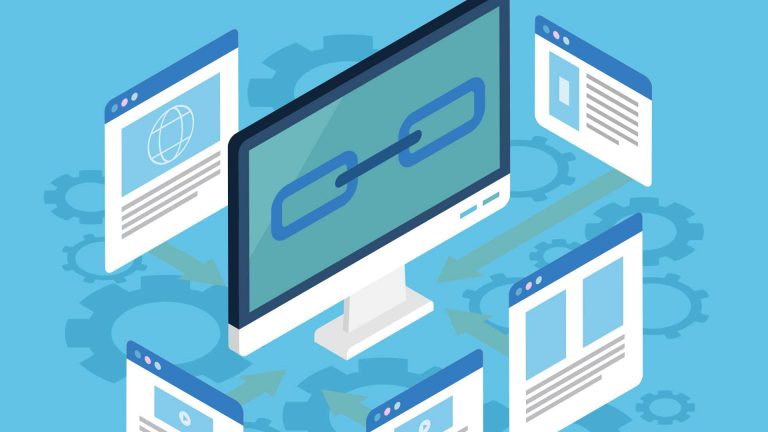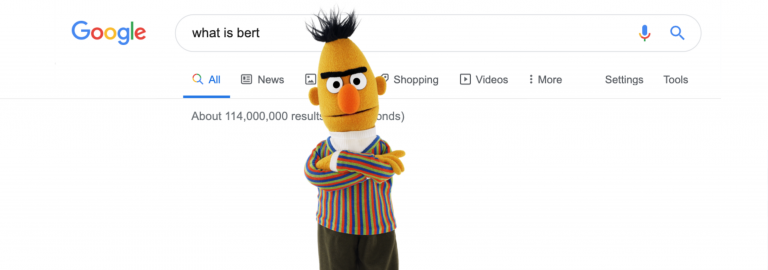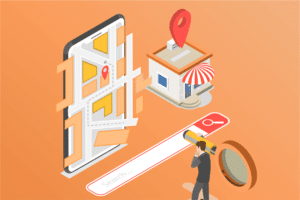Have you ever been in a situation where you had to strike a conversation with someone you’ve only just met? You struggle to find the balance between sounding warm and engaging without coming off as intrusive. It’s not easy, especially if you’re not the chatty type.
Sending a cold email is pretty much the same thing. It involves drafting an email to a potential client who has had no prior relationship with you and your agency so you can sell them your SEO or any digital marketing services. You can think of cold emailing as starting a conversation with a complete stranger—it’s all about making a great impression on the spot.
But, a cold email is not much different than real-life conversations. Cold emails—poorly done ones, specifically—can go straight to the spam folder. Or worse: ignored.
Before you get excited and hit send, you need to retrace the basics and learn how to write and send a cold email that evokes the best response from your reader. We’ll teach you how to write cold emails in minutes so you can start reaching out to your leads.
1. Setting Up Your Infrastructure (Staying out of Spam)
Every successful digital marketer has to learn how to write a cold email, whether they like it or not. Part of that journey is the learning curve of setting up a practical cold emailing process that targets real leads, passes spam filters, and converts readers to clients as quickly as possible.
Building Trust through a Domain and Software
You’ll have better chances of warming cold leads if you have a business domain on your email rather than using “@gmail.com” or any generic email address. A domain establishes authority, backed by transparency you display online, this is what starts building the trust between you and your potential client.
When you’re using your own domain, your email marketing provider may require you to edit your DNS settings to add in DKIM and SPF, commonly referred to as your DMARC records. At a glance:
DomainKeys Identified Mail (DKIM) records function as certifications to guarantee emails are genuinely coming from you. Through an encryption key, they prevent potential impersonators attempting to use your name or agency.
Sender Policy Framework (SPF) is the authorization between servers. It’s the “mark” of where you’re sending your message from and where you’ve allowed it to be sent from.
Combine the above, and you have your Domain-based Message Authentication, Reporting & Conformance (DMARC) records complete.
Some of the most popular email marketing platforms such as ActiveCampaign, SendinBlue, CampaignMonitor or Aweber will give you the option to use their IP addresses to send emails. But ideally, you want to create DKIM and SPF records to improve trust with spam filters and other email security devices while sending emails.
Adding DKIM and SPF Records
Adding DKIM and SPF records to your website is easy. You’ll need to add them via your DNS editor located in your CPanel > Domains > DNS Editor. If you’re using Cloudflare, it’s located under settings > DNS Editor.
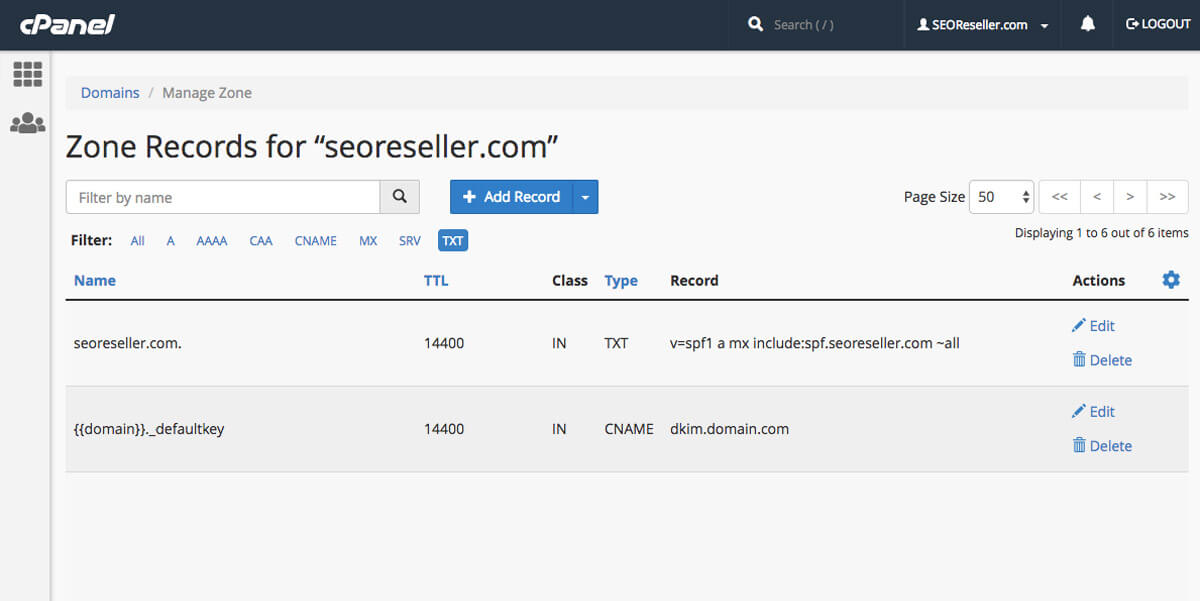
Simply enter your SPF and DKIM records, and within 24 hours, your domain and email marketing service provider will be connected and running smoothly. It’s recommended, that when you start cold emailing at mass volumes, to send to trusted friends to open the email, so your domain won’t be blacklisted or marked as spam.
The POP/IMAP Alternative
Another way to send cold emails is to link your email account to marketing automation tools via Post Office Protocol (POP)/Internet Message Access Protocol (IMAP). The software acts as a reader and an authorized email client with permission to perform actions with your email, such as reading, sending, deleting, and back up.
The great thing about going via POP/IMAP is the setup can be instantaneous. Our marketing automation, for example, allows you to link your email account to the marketing automation software and send emails as if they came directly from your email address. This also includes a reply-to option that directs emails straight into your inbox. It’s a simple integration that can be done via email settings your dashboard:
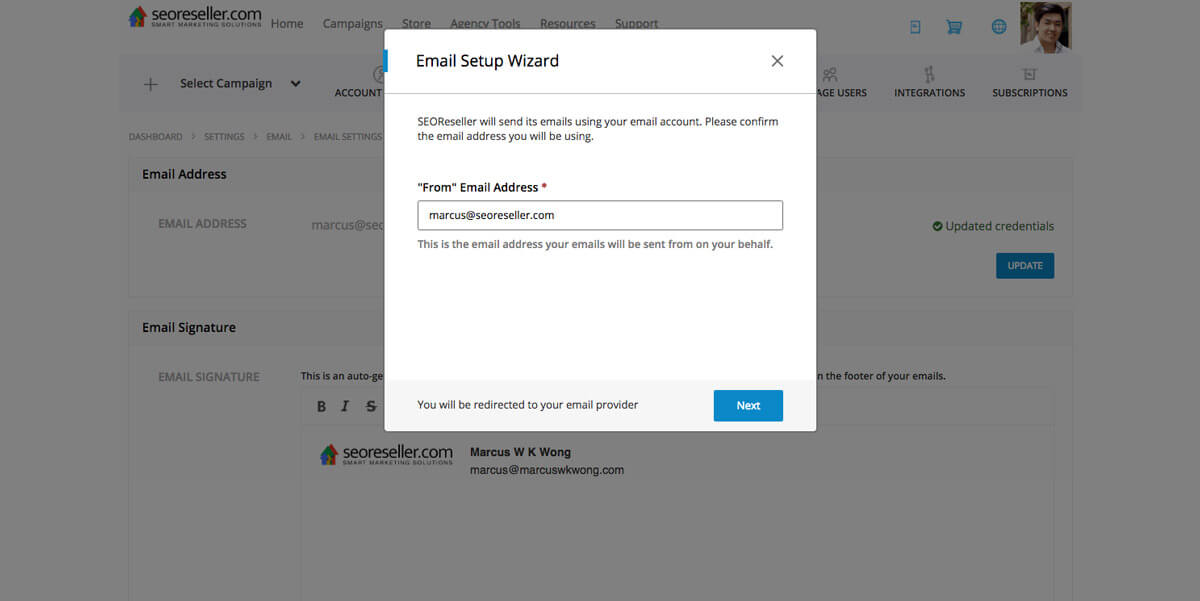
Respecting Email Etiquette
It’s good to remember that not all your readers will want what you offer. Although it might be a pain to see some readers go, the unsubscribe button is more beneficial to your business than you think.
With an unsubscribe link at the end of your email, it’s your way of telling your reader you understand they have the freedom to opt out of receiving messages from you. This also helps reduce spam complaints and lands your message in the inbox of your readers.
Plus, quantity doesn’t equate to quality. It’s always better to have a handful of active, happy clients than hundreds of inactive, uninterested ones.
2. Build Your Audience and Approach.
An important part of cold email marketing involves making sure your message lands in the inbox of the right people.
There are two ways to find your niche and build your audience. Deciding who they are and what your audience is focused on will help you when it comes to optimizing the approach you’re delivering. Of the two ways to build an audience, either:
- Go for an industry you really know or;
- Start with under-targeted, profitable niches
In the end, it’s all about your competitive advantage and what you can market towards. Whether they’re service or product-oriented businesses, industrial or medical niche, SMEs or corporations, you need to know:
- who they’re targeting to grow their business
- how they’re striving for growth for their business
Once you’ve defined the market and approach for your target audience, understanding how to enhance their growth strategies with your services becomes clearer. As a result, building your audience, and optimizing your approach becomes easier as well.
Study and Learn Your Target Niche.
Your email should serve as an information source of how you can help your prospects. Do your research on the industry and learn their language. Read blogs and join forums to get insights on what information your target audience is looking for. Talk about a specific problem in that niche and propose solutions to address this.
Using this problem-solution approach makes it easier to highlight your agency’s unique selling proposition (USP) and pitch this according to their level of need.
Define Your Approach.
These are some elements that your cold email template needs to contain:
A Killer Subject Line
Let’s start off with the first thing prospects will see when you send a cold email: the subject line.
This is one of the trickiest parts when writing cold emails. You need to connect with your prospects and compel them to read your message the moment they see your cold email subject line.
Here are a few pointers in making a cold email subject line that gets clicks:
- Don’t write clickbait or sales-y subject lines – It’s a dated way to write subject lines. Some might even consider your email as spam if you go down the clickbait route.
- KISS (Keep It Short and Sweet) – The shorter the subject line, the better. This is to avoid the subject line from becoming truncated, which prevents prospects from seeing what your email is about. Keeping it short is no excuse for boring subject lines, though. Choose each word wisely and stay relevant to your target niche.
- Don’t forget to A/B test – The purpose of A/B testing is to know which of the subject lines are effective for cold emails, and this is fairly easy to do. You only need to send two different subject lines to two different mailing lists of the same audience segment and see which subject line performs the best.
Personalized Message
Nobody likes receiving chain mails, more so if it came from someone they don’t know. When you’re sending a cold email, don’t make it obvious that you’re using a template and sending it to thousands of people in your mailing list. Remember that real people will see your message, and a generic email won’t leave a great first impression.
Personalization is important, and here are some ways to do it:
- Create a feeling of belonging – An emotional hook is like the secret sauce of your cold email campaigns. In general, people like to feel admired, accepted, and needed. Emails that make people feel like they’re part of an exclusive group or cause can be very effective. Create a strong brand image and nurture a sense of exclusivity around your product or service to make your reader feel special.
- Make it conversational – Even if you’re only talking through email, you still need to maintain a conversational tone. Find common ground so you can establish rapport easily. Research about them to know what information will likely catch their attention and start a conversation the same way you’d engage with a stranger.
- Know their name, their story, their needs – At one point in the cold email, you’re going to introduce yourself. That’s where you stop. Your cold email isn’t about you—it should be about them. Your cold email should have their name on the greeting or subject line; it shows you know who you’re talking to. Acknowledge their needs and show that you can address them, which brings us to the next point…
Asking for Honest Feedback
How are you going to solve their problems? What can you offer that others can’t?
It all comes down to value.
Don’t beat around the bush. An effective cold email should highlight the solution that you offer. Focus on your main message, but don’t be pushy. Avoid overselling your product and services because that’s when prospects are more likely to delete your email—or even send a negative response.
How exactly do you show value?
- Send content that they’ll love – Sending a cold email to a potential client is not just a way of connecting with them; it’s a strategy to get your content out there. It’s important to send content that resonates with the prospects at the Awareness State of their Buyer’s journey. Industry tips, methodology explainers, how-tos, and product guides are all excellent content for cold emails.
- Offer insight – Don’t brag, but show them you’re an expert at what you’re doing in your cold email pitch. This will not only leave a good impression to your prospects but also help your agency build its credibility. A good example is when you’re emailing them about your professional SEO services. Show them a few SEO stats to help them better understand what search engine optimization is.
3. Write Cold Emails that Sell
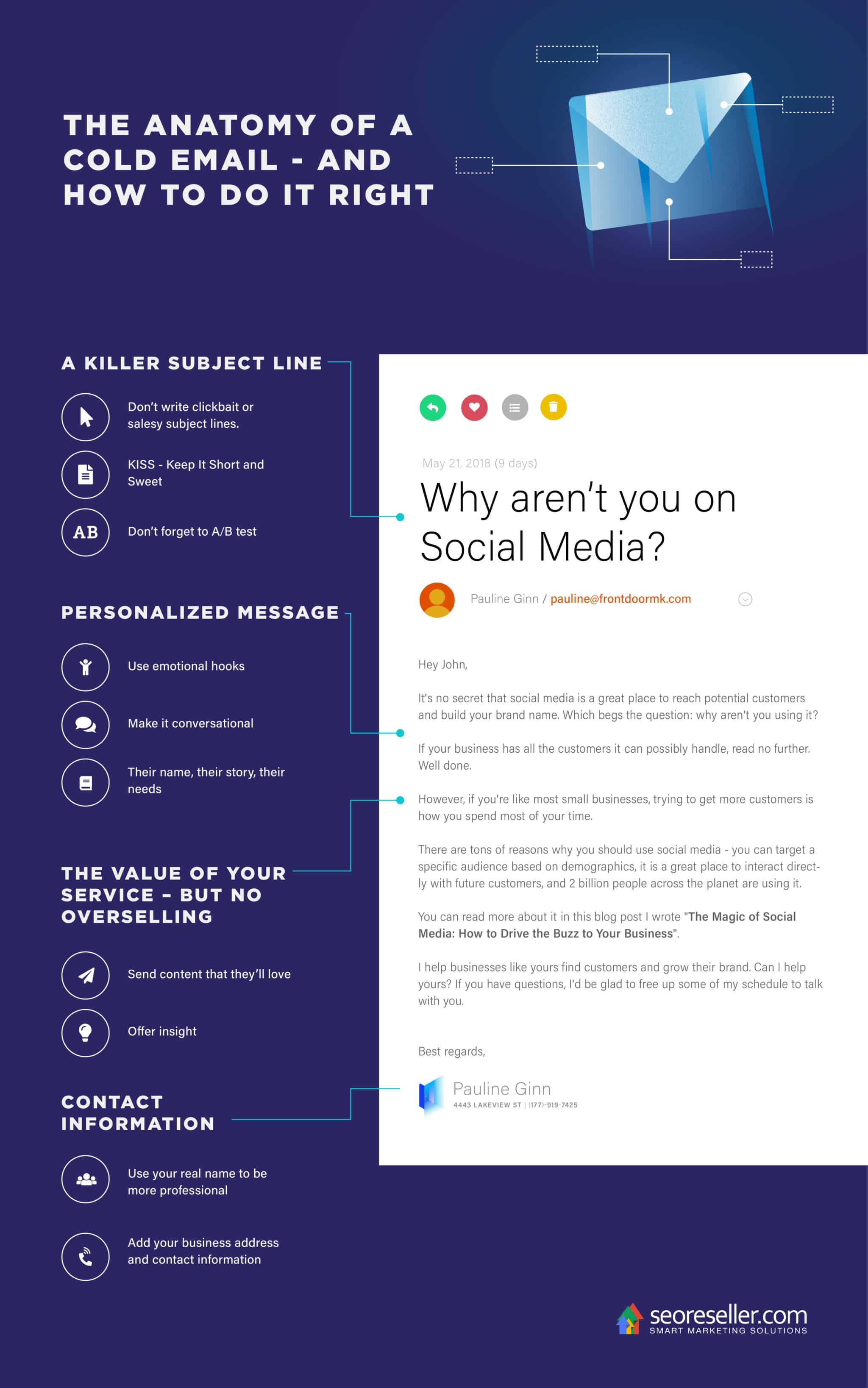
Mastering the art of cold emailing is more than just getting the first message right.
Your focus in a cold email is based on your success rate of channeling complete strangers from a targeted niche into your conversion funnel and ultimately turning strangers into leads and SEO leads into customers.
Here’s the breakdown of what a great single-file cold email sequence will contain:
The Primer
This is where you start with the value they’ll love. Remember, you’re stepping into their industry while soft pitching value that they may already have, are unhappy with, or have never received before.
Every industry is different and the approach will always vary. The first cold email that you’ll be sending to prospects should contain:
Immediate value that tackles their professional needs
Depending on the level of who you’re messaging—whether they’re the CEO of an agency or an employee—you want to make sure the value you’re offering in the first message tackles their professional needs first. Make it obvious for them to see how you’re contributing to their career or business.
Setting the proposition to focus on their customers first, then their business
Every successful business owner cares first and foremost for its customers. That’s why you need to recognize where the gaps are and architect your first email to address their customers’ needs with your lead’s products and/or services.
A great example of this:
Optometrists in Texas
The Problem: Not everyone needs prescription glasses, but the demand for sunglasses is consistent, especially in the warmer seasons.
The Hidden Value Proposition: The cost of sunglasses will vary from brand to brand, but the sales value is higher than that of prescription glasses.
New Business is Good Business: Creating a demand is just as important as finding the pre-existing demand,
Take the above data, and your first cold email template should look like this:
Example:
Hi Dr. {{surname}},
I came across Houston Eyewear when I was looking around for sunglasses, and I love the collection that you keep in stock. I just referred you to a friend of mine who was looking for UV-coated sunglasses (polarized).
I’ve been in digital marketing for {{X}} years, and I’d love for you to look over a plan I have, and see if this is something you’d like to work on together so more families and young adults in Houston can find you and consider you as their go-to optometrist.
Would you be interested? I have time this week if you’re available and I’ll be happy to set an appointment with you. Is anytime between {{time}} and {{time}} on {{date}} okay with you?
Regards,
Bernard San Juan
Head of Awesome – SEOReseller
000-000-0000
Pro tip: To target effectively and at scale, set a specific range of hours on a day. You might not always get the ideal time slot with them, so it’s best to give a range as the option. Set a specific day to email, and another day to follow up either as a call or a visit.
The Follow-Up
Your goal for the follow-up email is to achieve what your initial cold email failed to do: get a response.
The follow-up email should contain the following questions:
Did you receive my last email? Do they have any feedback or thoughts that would contribute to the value? This email shouldn’t be too long. In this email, you can start to test your style, tone, and approach.
Hi Dr. {{Surname}},
I hope you’re doing well.
In case you missed the email I sent earlier this week, I have a digital marketing plan to make Houston Eyecare more visible online and help you gain more customers. I’d love to hear your thoughts about this and explore opportunities with you.
Let me know if you’re free for a chat anytime this week.
Bernard San Juan
Head of Awesome – SEOReseller
000-000-0000
Do you have additional questions about the product/service? Your prospect might be interested in learning more about your solutions. Use this opportunity to give them a little nudge.
The Second Follow-Up
The second follow-up is intended to pursue a response while assessing if they’re still the appropriate reader for your emails.
Are they the right person you should be speaking with? If not, do they know who is the best person in the company to speak with? Do they know other business owners who might be more interested in your products and services?
Always leave a lasting impression. You want them to remember you and show that you’re worth their time. When following up, reiterate the value that you’re offering while asking probing questions. The secret is to tickle their curiosity so they’re motivated to respond to your cold email.
Hi {{Name}},
I spoke to {{Name of Referrer}} who forwarded your details to talk about an opportunity to get more eyes for your business.
In my previous conversation with {{Name of Referrer}}, we were discussing how Houston Eyewear is not getting as many sales for your collection of prescription glasses.
So I came up with a plan to make Houston Eyewear be recognized as the optical experts that everyone in Houston can turn to. {{Name of Referrer}} suggested I also consult you about this, and I’d love to hear what you think about it as well.
Is this something that would interest you? If you’re available this week, I’m happy to arrange a meeting/call with you – I promise I won’t take up much of your time. Does {date} between {time} and {time} sound good to you?
Regards,
Bernard San Juan
Head of Awesome – SEOReseller
000-000-0000
4. Do’s and Dont’s When Sending Cold Emails
DO use your real name and business address.
Always write a cold email using your real name. Your business address should also be in your signature. This indicates that your agency is legitimate and has an actual place of operations.
DO be transparent.
Remember the Facebook fiasco involving Cambridge Analytica? You don’t want to cause the same kind of panic as that with your cold leads. When you’re sending a cold email, be honest about where you got their information and remind them about opt-out options from future emails.
DO be wary of the time you send that first email.
Timing is everything. Sending a cold email on a Friday night is not a good practice, simply because the person on the other end of your email has likely gone off to enjoy the weekend. That means your email is going to sit in their inbox for the next two days. The best time to send an email—based on our experience and response rates—is around 10-11 in the morning, as this gives them ample time to go over your email.
Pro-tip: Don’t forget to check the timezone of your cold leads, so you don’t blast them a message when it’s 3 AM on their side of the world.
DO speak their language.
Using familiar words that they’re synonymously used to makes you appear at the highest trust level because you can synchronize to their wavelength. Knowing their industry-speak helps you paint a picture of how your solutions fit into their business. A medical example of this would be, instead of an “audit,” you may want to find more commonly used alternatives in their industry, such as a “digital diagnosis” or an “online examination and assessment”.
DO test the tone of your sequence.
How you approach your prospects in an email is just like how you initiate a conversation. While your goal is to get them to convert and be your customer, don’t sell to them immediately. Your email should reflect what interests your prospects and what their goals are. Talk about their pain points and make an effort to ask questions that will prompt them to respond.
DON’T forget to include your contact details.
If you truly want to get a response from your cold leads, layout everything for them. This includes sharing different ways to contact your business. You can add your contact information in your email signature or use a scheduling tool to attach contact links in your message. This way, they know how to get in touch with you when they’re ready.
DON’T exaggerate.
One of the common mistakes of marketers when they send cold emails is making bold claims. Overpromising will only make your reader question the intent behind your email and pass you off as self-promotional content.
DON’T “pick” your audience, build your audience.
Picking your audience becomes a one way street uphill to a destination that may catch you out of luck. Being as prepared as possible when it comes to building your audience is all in the research of the right metrics, who they are, what they need, the clientele they need to build their business, and who they want to achieve this for them.
“For open rates, we consider 30% as a good benchmark”
Measure, Test & Repeat.
How do you know if your cold emails are effective? Test and measure. This will allow you to replicate the steps for your next cold email marketing campaigns. The final metric that matters is inevitably the sale, but the metrics that help you determine whether you’re likely to have achieved the sale of your cold email marketing campaign or not are based on:
- Open Rate
- Response Rate
- Call to Action / Click Through
Set a benchmark for yourself and goal for each metric so you can determine which areas of your cold email marketing campaigns need improvement. For open rates, we consider 30% as a good benchmark.
Remember, the goal of the message is to build trust and interest. Your open rates will reflect how well you build interest, and your content will build trust. You can test to improve your email metrics is:
- Subject Line
- Email content and verbiage
- Signature
- Time of sending
- Approach (are you setting an appointment or are you asking for a call?)
A Reminder on Buying Email Addresses
There’s always been a market for lead generators to sell email addresses to digital marketing agencies. With list sizes as small as ‘1’ to numbers into the millions, buying email addresses for marketing purposes has always been present, not just for cold emailing but for ad-retargeting on social networks as well.
When it comes to buying email addresses, be warned, the resulting list is more than likely to contain:
- Spam traps that will block your emails being received, and report you to blacklists. These are regular looking emails, however they are not built for communication, rather the sole purpose of identifying spam emails.
- Emails of individuals who have moved on from businesses that are no longer existing. Consider the age of the list as a priority—how old is the list and how long ago was it compiled? Depending on the industry, people move, fast.
- Email addresses that will bounce. These are email addresses that don’t exist, either past or present and may just be used as “filler” emails to the list.
While we don’t advise buying email addresses and instead building a list of your own that you can personalize, there are services that exist such as neverbounce to help you ‘clean’ the email list of spam traps, and test emails for deliverability.
Final Thoughts
Once you get through that initial cold email sequence, the next ones will be a piece of cake. You’ll find it easy to write your cold emails in minutes and have them ready for sending to your leads.
Always look for the opportunity to optimize your messaging and approach. Build habits around a weekly cycle to check your cold emailing sequence.
Get to the right inboxes and build your database of cold outreaches. Cold emails can provide results that matter for your business: more clients.
The most important thing to remember is that cold emailing is about starting a conversation, with the goal of a response as your first measure of success, and the follow-through as your pitch.

